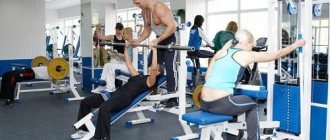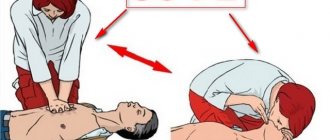Cardio training is primarily aimed at training the heart muscle. This is an important part in bodybuilding because... Many people neglect these workouts. And they are very important for the health of the cardiovascular system. In this article we will look at the main myths and give recommendations for this type of training.
Cardio exercises include: running, walking, jumping, cycling.
Types of Cardio Training
To avoid any possible confusion, let's look at the most popular types of cardio and talk about how they are mixed with strength sports.
- Running (can be replaced by brisk walking) is a great way to warm up in the morning, recharge your batteries, ventilate your lungs and the entire body as a whole, and at the same time burn a couple of hundred calories. The condition for such training is to not run too fast so as not to become completely exhausted. On the other hand, it shouldn't be an easy walk that won't even make you sweat. You need to tune in to your own optimal rhythm and run three to six times a week, setting aside an hour or an hour and a half for this. This will not only strengthen your body, but also help you become drier and more toned.
- Swimming is the best form of cardio because it is difficult to exceed your maximum effort limit. You don’t just need to stay on the water, but swim for fun, completing your workout with a 200-500-meter swim without stopping. Such cardio training can bring literally fabulous results. This is because, unlike running, swimming limits breathing. The body perceives this as a signal and begins to strive to increase the volume of the lungs, which means that the supply of oxygen to the entire body will improve. Additional benefits are the strengthening of the immune system due to contact with water. Muscles in water relax and recover faster. Just like marathon runners, swimmers have a much lower release of lactic acid into their muscles, so people who strength train with iron have the opportunity to train even more productively.
- Treadmills and exercise machines simulate running. This kind of training takes place indoors, which is pretty bad. If there are no options or if the simulator is installed at home, you can train in this way, but it must be taken into account that the lack of sunlight and clean air rich in oxygen, with increased stress on the heart and blood vessels, requires such training to be strictly dosed.
- Circuit training, otherwise called “functional training” These types of training arose quite a long time ago, but became popular no more than a year ago. Their essence lies in performing strength training with a weight significantly less than what bodybuilders use - five or even ten times less than the usual working weight, but the exercises are performed in a circle three to five times, without rest. This looks quite attractive, but it is not only a colossal load, but also a high danger for blood vessels and the heart. However, it can be clarified that this danger occurs only for a person who does not have the appropriate training and is unfamiliar with the technique. The lungs of such a person have not yet acquired the skill of supplying oxygen to the body in a critical mode for 15-20 minutes at a time.
For clarity and specific numbers, look at the infographic:
Cardio at home
What is important to consider when doing cardio at home? The same aspects as in other cases - tracking heart rate, tracking lost calories, taking care of joints. If you don't have a heart rate monitor at hand, you can focus on your breathing. If the load is too high, it will go astray and it will be difficult to talk.
There are a lot of exercises in the home athlete's arsenal. For example:
- Jogging in place is a good alternative to regular running. “Run” by intensively trampling from foot to foot, alternately raising your knees, with your heels touching your buttocks - diversify your training.
- Jumping in place – Alternate quick, shallow jumps with squat movements.
- Burpee is a CrossFit exercise.
- Elements of aerobics and dance.
It's great if you have an exercise bike at home. Without taking up much space, it will help cope with excess weight and other problems that fall within the “competence” of cardio. The abundance of aerobic exercises leaves no reason to give up cardio exercises - you can do it in any conditions.
Who needs cardio training and why?
Let's see who is recommended for cardio training and in what cases it is better to use it.
- It can be recommended to all elderly people, as they help maintain the cardiovascular system in order and prolong life.
- When exercising the goal of building muscle mass, cardio training is undesirable, since it causes an effect on muscle growth that is opposite to hypertrophy. But, since you cannot build muscle and burn fat at the same time, it is advisable to include cardio in your training plan along with strength training during the fat burning phase, since this will make fat burning more effective.
- If you have set a goal to lose weight, it will be very good to add cardio to your strength training, although cardio alone is not the best way to lose weight.
- Cardio training is good if you are involved in cyclic sports and you are required to develop endurance.
- Cardio is good for recovery. With light loads, recovery occurs more quickly.
- Many people advise using cardio training as a warm-up - to warm up the body for 5-7 minutes before starting a workout. Although this is not exactly cardio, but rather a regular warm-up.
How to choose a load
Thanks to the functions of modern cardio equipment, the load is set automatically; it is enough to set the following parameters: gender, age, weight, exercise time and mode (interval, inclined walking, acceleration). If cardio training includes strength exercises and jumping, then you need to monitor your heart rate yourself. Pulse is the only indicator of the correct degree of exercise. The main thing is that it should not be lower than 120 beats/min, and not higher than 160.
Cardio training is not the best way to lose weight
This is a fairly popular misconception among women involved in fitness: hoping to lose weight and being afraid to “swing”, in all the fitness rooms of the world they storm ellipses. But you don’t have to worry - it’s simply impossible to “swing up” without hormones and steroids. But if cardio training is used exclusively for weight loss, then this is indeed a misconception, and a very common one at that.
Indeed, in 45 minutes of cardio training you can burn more calories than during the same duration of strength training, but for weight loss the overall effect will be worse. Strength training works differently - it burns fat not during training, but after it during the rest process, which significantly increases the overall metabolic rate. Thanks to strength training, you will gain even a small amount of muscle, for example, 5 kg, but they will already require adding 250-400 additional kilocalories per day to your regular diet. As a result, it becomes easier to maintain some calorie deficit and burn fat on a consistent basis.
The maximum effect for burning fat is observed when combining full strength training with cardio training. Fitness experts recommend doing 2-3 strength training sessions per week to lose weight and adding 2-3 cardio workouts lasting 45-60 minutes, and it is better to choose different days for training.
Why is this type of training needed?
Cardio training, performed with or without machines, makes the body more resilient. Regular exercise increases the vital capacity of the lungs, increasing the oxygen saturation of tissues and internal organs, which is why cardio training is also called aerobic.
During strength training, a different mechanism is involved, which is why they are called differently - anaerobic.
Cardio exercise speeds up your metabolism and triggers the fat burning process. As a source of energy during cardio training, the body takes glycogen from subcutaneous fat and liver.
When is the best time to run?
1. Run on an empty stomach
Modern research has found that exercising for 30-60 minutes in the morning, immediately after waking up, allows you to burn three times more fat than similar exercise at other times of the day. The fact is that the main source of energy for the body throughout the day is carbohydrates coming from food. During night sleep, these reserves are depleted by the body. Therefore, when a person wakes up, carbohydrates no longer play their energy role and fat begins to be used for energy.
Interestingly, morning workouts increase your metabolism throughout the day, so after working out on an empty stomach, your body will burn more calories throughout the day.
Attention! It is definitely worth considering for those who have good muscle mass that training on an empty stomach is contraindicated for them, since if there is a lack of fat, the body will begin to burn muscle. So this method of losing weight is only suitable for those people who have something to lose, that is, there is excess fat mass.
In the state of Kansas, a study was conducted that showed that when exercising in the morning, one kilogram of fat was oxidized faster than if physical activity was performed closer to the end of the day. A cyclist who pedaled in the morning before breakfast burned 60% more fat than one who exercised at lunch.
For muscular people who want to improve their muscles, running in the morning on an empty stomach is contraindicated. In general, running in the morning is good, but in terms of losing muscle instead of fat, doing cardio on an empty stomach is bad. Therefore, you can create the following morning jogging schedule for yourself:
- get up early, no later than 6-7 am;
- have a light snack without meat, for example, eat 4-5 boiled eggs with a glass of juice and bread;
- after eating, take a 30-45 minute break;
- go for a run.
So, for those who want to get rid of excess fat mass, it is advisable to run in the morning on an empty stomach, and if running is considered as a way to develop muscles, it is better to eat before cardio.
2. Cardio before strength training
For men seeking to gain muscle mass, aerobic activity in any form one to two hours before working with iron is absolutely contraindicated. Cardio done before strength work will lead to depletion of glycogen reserves, as a result of which you may simply not have enough strength for the last two or three repetitions, the most effective ones, which stimulate growth most of all. Another argument for not needing cardio before exercise is that running leads to decreased protein synthesis and increased protein breakdown. With strength training, the opposite happens: protein synthesis remains at the same level or increases slightly, but protein breakdown increases.
Thus, it turns out that after cardio training, protein synthesis, which refers to the human body’s ability to form new muscle structures, decreases, and if you then go to strength training, your ability to build muscle mass will decrease significantly. Therefore, cardio, especially for a long duration, leaves its mark on muscle progress. For women who do not want to have large amounts of muscle, who train at low intensity and with light weight, you can easily afford a 20-25-minute jog.
Thus, before training, cardio training may well be carried out, but after it it is necessary to wait a certain time - 2.5 - 3 hours in order for the glycogen depot to be restored. The correct diet and the use of appropriate sports supplements, such as carbohydrate-protein shakes or gainers, will allow you to speed up this process.
3. Advantages and disadvantages of cardio after strength training
Such cardio workouts are more beneficial than those performed before strength training. The reason is that during strength training, glycogen stores are not as depleted as during aerobic activity. So after completing your workout, there will still be a sufficient amount of stored glycogen in your muscles, and you will be able to run your race at a high level. You can get even more effectiveness from cardio if you wait two to three hours after class, eat, and only then go for a run. In this way, you will quickly replenish glycogen reserves, the breakdown of proteins will be stopped and the body will be ready to put all its efforts into a run, because it will no longer have to worry about restoring “post-workout holes.”
Before or after strength training?
Is it possible to combine cardio and strength training in one day? You can and should, but never do cardio before lifting weights.
. In this case, your glycogen stores will run out. Respectively:
- there will be little energy on the power supply;
- you will do less work;
- muscle hypertrophy will be less;
- Fatigue increases the risk of injury.
Another reason not to do cardio before strength training is mTOR inhibition.
signaling complex that ensures muscle growth.
This makes it even more difficult to gain muscle mass.
A study by Goto K. et al. [39] showed that moderate static cardio training immediately after strength training burned more
fat
compared to doing cardio alone. At the same time, the break between strength and cardio training should be short (up to 20 minutes).
Conclusion:
do cardio after you finish lifting weights or during your free time/rest day. If your goal is to burn fat, the best time to do cardio is immediately after strength training.
Best results from cardio
Everyone wants not just to run, but to achieve certain results - improve their physique, heart function, etc. Therefore, to achieve these goals, you need to know exactly the time of your intended run and plan your runs accordingly. You can follow these tips:
- if you plan to train your legs in one of the strength training sessions, then cardio should be done away from this day, for example, training your legs on Monday, run on Thursday or Friday;
- Do cardio training on days when you don’t have strength training;
- If you can’t set aside separate days for jogging, practice jogging after finishing your workout.
If the body is 100% charged with energy, you will get much more benefits, that is, an increase in muscle mass, an improvement in appearance.
General rules
Firstly, the body must be completely healthy, or you need to exercise under the supervision of a doctor or an experienced trainer.
Classes should be conducted outdoors or in a well-ventilated area , without the use of air heaters or air conditioning. Such devices burn oxygen, which is necessary for oxidative processes in the body.
The workout should not last more than an hour and the intensity should not exceed your training level. That is, beginners do not need to run 10 km/hour ; this will not benefit either health or weight loss.
What pace should you run for cardio?
The running intensity must be calculated using a formula that is tied to the maximum heart rate (HRmax). This frequency is defined as follows:
HRmax = 220 – age.
So, for a 17-year-old person, the maximum heart rate is 220 – 17 = 203. During cardio training, the pulse should be from 65% to 85% of the calculated maximum.
They also often talk about the pulse zone for fat burning (most likely because it is often noted in fitness rooms on cardio equipment). This zone is also determined individually by testing with a gas analyzer. This norm is slightly lower - it is 60-70% of the maximum heart rate. For the average 30-year-old person, the norm is 115-135 beats per minute. However, we must not forget that cardio training is not particularly effective for burning fat.
Cardio training tips from the pros
- Cardio training is beneficial if a person does it correctly , that is, he needs to monitor his pulse.
- During training, you need to constantly monitor your heart rate . For this reason, many advise using additional equipment during training, this is especially important for those who have a tendency to increase blood pressure or problems with the cardiovascular system.
- Before training, you need to determine your goal : active heart training or weight loss. In the first case, the training should be more intense (heart rate at 85% of the maximum upper mark), but shorter in time (on average 15–20 minutes. If the goal is to lose excess weight, then you need to prepare for a training session of 40–60 minutes, but with a lower intensity - 65% of the upper limit of the pulse.
- It's best to start with 10-15 minute sessions at low intensity.
- When choosing the time of day for cardio training, it is worth remembering that the degree of load in the morning and evening is different . In the first half of the day, the intensity of exercise should be lower - approximately 100–110 beats per minute for beginners, and 120–125 beats for regular gym visitors. Evening training should take place in a more intense mode with a pulse of 130 beats for beginners and 140 beats for advanced ones.
- Only a gradual increase in the load and intensity of training loads can ensure safe and effective training. If you follow it, then within a month, with the same exercise regimen, the pulse will be much lower, which means it will be possible to increase the degree of load. To move to a new level of intensity, you can use the so-called “verbal” test: during training, the person must be able to speak calmly. And then, as professionals point out, you can gradually increase the load.
Should you eat after cardio training?
Many believe that eating after a race is like death, because it undoes all the work done so reluctantly. If you think this way, you need to reconsider your point of view, because it is wrong. If you don't eat after a run and instead go hungry, your body will begin to develop a tendency to store fat. Therefore, you should definitely eat right. This doesn't mean that after running you have to bury yourself in the candy department. Proper nutrition includes the following foods: protein shake, fish, chicken, brown rice, buckwheat.
Examples of aerobic exercises for beginners
- Jumping rope – 300 times;
- Jumping on a bench – 4 sets of 20 times. We jump onto a hill with both feet at the same time. We lower our feet one by one to the floor;
- Long jump. We perform the maximum jump forward, and also return to the starting point. We do 20 jumps at a fast pace;
- Shuttle running with maximum acceleration of 10 meters forward and backward. The duration of the exercises is 30 seconds. After running – 1 minute rest, repeat 3 more times;
- Burpee. From a standing position, we lower ourselves to a sitting position, lowering our palms to the floor, and jump into a lying position. We touch our belly to the floor. We jump back to the palms. Jump up to a standing position. We repeat the exercise 20 times for 3 more approaches.
How long do you need to run to burn 1000 calories?
The information below comes from an American magazine dedicated to running and weight loss. It traced the connection between fast food consumption and running, that is, how much you need to run to compensate for various foods. The results were as follows: if a person runs at a speed of 7-9 km/h, that is, at a moderate pace with a heart rate of 65-75% of the maximum, then with an average build (70 kg) he burns approximately 550-600 kcal/hour. So jogging a distance of 1.6 kilometers allows you to burn 100-120 kcal.
Description of the mattress
The Askona Cardio mattress series is designed for active people who need quality and healthy rest. The sleeping conditions are truly comfortable and luxurious. The design is based on a block consisting of independent elements - HourGlass Extra, which is popularly called an hourglass. Promote optimal positioning of the spine and uniform distribution of loads, guaranteeing orthopedic support. The surface consists of five zones characterized by different levels of rigidity, which has a beneficial effect on the spine.
Each spring block has its own cover, located in the central part of the structure and preventing contact or friction of individual elements located inside the mattress with each other. Each block takes on a certain load without depending on its neighbors. This ensures ideal support for the back and spine in particular. It is possible to use Askona Cardio mattresses as a preventive measure for numerous diseases associated with the spine. To increase the service life and increase protection against contamination, it is recommended to use branded mattress covers.
Which form of aerobic activity to choose?
Everyone understands that you can run in different ways. Some people think that they need to run at a slow pace to lose weight, while others advocate the benefits of interval cardio. We will describe four types of aerobic activity that allow you to achieve fat burning and “cultivate” muscle mass.
1. Low efficiency cardio (LOI) . This is the well-known jogging. It not only affects body composition, but helps reduce muscle pain and promotes the restoration of muscles damaged by microtrauma, since blood enriched with nutrients is intensively delivered to the muscles. CNI is not only jogging, but also cycling, exercise on a treadmill at a low speed. With CNI, the energy of free fatty acids is used predominantly, with carbohydrates coming in second place as an energy source.
During CNI training, it is advisable to take additional proteins and amino acids, which are present in sports nutrition, to maintain and preserve muscle mass. When training at low intensity, it is necessary to maintain your heart rate within 60-65% of maximum. For a cardio workout that lasts 30-45 minutes, you should stay lightly hydrated throughout.
2. Moderate-intensity cardio (MIC) is an intermediate option between sprinting and jogging. The main goal is to perform work at an active pace, while the level of effort must be maintained over a long period of time. When running this way, you need to focus on breathing and constantly maintain your target heart rate zone within 65-70%. It is necessary to perform QSI for at least 30 minutes, while no rest is allowed and the pace should not be lost even for a second.
With this type of cardio, the source of energy is not only fats, but also carbohydrates. To preserve and maintain normal muscle mass, it is necessary to additionally take amino acids and proteins. 5-7 minutes after the start, such running leads to increased sweating, so you need to be wary of dehydration and drink water as you go.
3. Interval cardio (IC) requires the same intensity as CNI, but with less concentration and attention. You can work without fear of possible disruption. The goal of this type of activity is to get a quick workout that results in an increased metabolism long after the activity is completed. Many studies have shown that IR provides an even better fat burning effect than double the duration of CNI - this is due to a higher metabolic rate.
Sprinting is intense cardio over specific intervals with active recovery periods of walking in place between runs. The second name for IR is HIIC (high intensity interval cardio). Due to the anaerobic nature of this intensity, it is primarily fueled by carbohydrates, so in order to achieve the best results, it is necessary to consume carbohydrates both before and after your running workout. The use of amino acids and proteins is required for muscle recovery, and cool water consumed during breaks gives a surge of fresh strength and a charge of vigor. To perform training according to this scheme, you can use the following schedule:
- train 2-3 times a week;
- Duration of an intense run – 15 seconds;
- in 15 seconds you need to run 50-60 meters;
- number of sprints – 20, of which 12 are at full intensity, 4 warm-up and 4 for cooling down;
- The total training time is 15-20 minutes.
- the cardiovascular system is trained;
- Strength and explosive abilities improve.
The athlete selects 2-3 exercises and ties them into one bundle. The weight is approximately 650% of the one-rep maximum. If you lift a barbell weighing 50 kg for the biceps for one repetition, then for circuit training you can use a weight of 25 kg. You need to repeat it 12-15 times, in three sets with a rest of 15-20 seconds between sets. So, one circle consists of 2-3 exercises, which are performed in a row one after another with breaks between circles of 15-20 seconds. This type of anaerobic activity uses carbohydrates as fuel, so they must be consumed during the session to fuel the body. It is also necessary to control the intake of protein into the body and constantly remain hydrated, that is, sufficiently hydrated.
Each type of cardio has its own characteristics, disadvantages and advantages, so it is not so important which type provides maximum efficiency: you can choose the one that you like best and from which you will enjoy. You can try all of the ones described above and choose your own. Any method creates an anabolic environment in the body and has a positive effect on body composition. The main thing is to use the chosen method systematically.
Cardio training program for fat burning
The proposed cardio training programs for burning fat are suitable for both men and women. Cardio training in the gym for girls is no different from men's.
Static cardio
| Time | Intensity |
| 0:00 – 2:00 | 4 points |
| 2:00 – 28:00 | 5 points, 66-69% HRMax (fat burning corridor) |
| 28:00 – 30:00 | 4 points |
Type of card exercise:
exercise bike, elliptical or uphill walking.
Execution frequency
: 5 times a week, after strength training (i.e. 3-4 times) and 1-2 times on rest days
Benefit
: one workout = 300 kcal, 5 workouts will burn about 1500 kcal per week + fat burning, increased endurance and other beneficial effects.
HIIT
This 4-phase cardio program for burning fat in the gym will take you from beginner to HIIT pro in 8 weeks.
Phase 1 (week 1-2).
Work-rest ratio 1:4
15 seconds - intensity 9 points;
60 seconds - intensity 7 points;
lead time
: 14 min (11 reps with a 15 second “snatch” at the end).
Phase 2 (week 3-4)
. Work-rest ratio 1:2
30 seconds - intensity 9 points;
60 seconds - intensity 7 points;
lead time
: 17 min (11 reps with a 30 second “snatch” at the end).
Phase 3 (week 5-6).
Work-rest ratio 1:1
30 seconds - intensity 9 points;
30 seconds - intensity 7 points;
lead time
: 18 minutes 30 seconds (18 reps with a 30 second “snatch” at the end).
Phase 4 (week 7-8)
. Work-rest ratio 2:1
30 seconds - intensity 9 points;
15 seconds - intensity 7 points;
lead time
: 20 minutes (26 repetitions with a 30-second “snatch” at the end).
Frequency of training according to the program
: 1-2 times a week, on rest days.
Type of cardio exercise:
exercise bike, elliptical or uphill walking.
Benefit
: Lots of calories burned, hormonal surge, fat burning, muscle growth, increased endurance!
Cardio workout without machines
Cardio can be done anywhere and without equipment , for example:
- go for a walk (light static cardio);
- do sprints (HIIT);
- jump rope (static or HIIT mode), etc.
You can find an excellent home workout program here.
How to lose weight with cardio
Not everyone enjoys running, so you can use other forms of aerobic activity instead. We also remind you that cardio is not the most effective way to lose weight quickly. We offer a few tips that may be useful when doing cardio training:
Tip #1: Replace walking with running. Everyone around you is indifferent to your weight, and only you yourself are interested in getting rid of it. Until you start running, you won't be able to lose weight. To begin with, you can alternate running with walking - run for two minutes and walk for two minutes, and so on for 30-40 minutes. You can gradually reduce the time you take breaks, and you will soon see changes in yourself.
Tip #2: Drink water during cardio. At the same time, one should not confuse the concepts of “wet your throat” and “drink as you should.” If you drink more than half a liter of water during an hour of cardio training, you will simply ensure that you are invited to the toilet. We experience thirst even if our mouth is simply dry. You can get it wet and move on.
Tip No. 3. What to do if you have a stitch in your side. This happens to everyone and most often they ask what to do about it. You don’t need to do anything, you can run a little slower, breathe more often and maintain the rhythm of your breathing, and everything will pass in a couple of minutes.
Training in cardio is an important part of the journey to reducing body fat, but it is not the only one. To achieve success, you need to combine several components, the most important of which is proper nutrition. We must not forget about this.
What does cardio training include?
Cardio exercise can be anything, as it includes working both on cardio equipment and with your own weight.
These include:
- run;
- fast walk;
- cycling or doing exercises on the orbit track;
- stepper;
- treadmill;
- catamarans and other types of exercise bikes.
And also, it can be jumping rope, shuttle running, various jumping exercises, interval exercises.
Reviews of the Ascona Cardio mattress
Marina: we bought the structure in 2020 and are still happy with it. The sleep is sound, my husband’s back has stopped hurting. The spouse is a truck driver, so he needs quality rest, which can be only a few hours. My frequent turning over in my sleep does not bother anyone, since each spring has separate springs.
Olga: We bought a mattress at the beginning of 2020 and were afraid of the smell. Then, however, after two days everything went away. But my husband and I were very scared. The seller did not warn us about this property of the glue used. The surface is not soft, however, it happens that we slide towards each other in our sleep.
Dmitry: There are no complaints. True, I sleep alone (not counting the dog). We don't bother each other. I stopped snoring (I often woke up from it myself). The back and sides don't hurt like with the previous bed. I'm happy with everything except the cost.
Contraindications
Not everyone can do this type of training at home or in the gym. If at the beginning of classes there is a deterioration in health, the manifestation of chronic and long-standing diseases, it is necessary to temporarily stop classes and, if possible, consult a doctor.
Here are the body conditions in which these workouts are contraindicated:
- Malfunctions of the cardiovascular system. If there are disturbances in the activity of the heart, you should be careful about training both at home and in the gym.
- Joint injuries, disorders of the musculoskeletal system. Training at home should be postponed until complete recovery if the indicated disturbances in the body’s activity occur. It is reasonable to resume classes after the doctor’s permission.
- Colds and viral diseases. Even a minor cold is a serious stress for the body. Therefore, during your illness you should avoid any exercise, including home exercise.
This type of exercise not only helps you lose weight, but also plays an important role in strengthening the body. Only their implementation should be treated with extreme caution so as not to aggravate the situation.
Features of cardio training at home
Cardio exercises at home are relevant for people who, for various reasons, cannot go to the gym. Don't think that practicing at home is less effective. This is far from true. With a strong desire and strict adherence to all the rules, you can quickly achieve the desired result. The only caveat is that you will have to control your physical activity yourself.
For beginners, three workouts weekly will be enough. In the future, their number can be increased to 5-6. But we look at how we feel. If our health allows, we train every day. It is important to enjoy and benefit from the process.
Characteristics
The design is able to withstand significant loads thanks to an independent five-zone spring unit, shaped like an hourglass. Each element of the spring is in a separate fabric cover, which eliminates the formation of specific noise in the future. Taking into account the peculiarities of the human structure, springs are placed near the hip, shoulder, cervical, lumbar and in the legs. A skillful combination of layers of different fillers made it possible to achieve an excellent orthopedic effect and give the surface of the structure an average level of rigidity.
This category of mattresses is considered universal and the most popular among modern consumers. The product is packaged in a jacquard case impregnated with silver ions. A warranty period of 25 years applies to models that are protected by an additional Ascona branded case.
Characteristic features of the model:
- long warranty period provided that a branded case is used;
- presence of micromassage effect;
- high orthopedic indicators;
- a cover impregnated with silver ions and other protective impregnations;
- product height 23 cm;
- permissible load on the bed 140 kg;
- medium hard surfaces;
- The design is based on blocks of independent springs.










